The ‘Evergreen state’ of Washington is a sweet, sweet place for birding. With locations like the Rocky Mountains, the Puget Sound Lowlands, and the Coast range to name only a few you’ve already got the recipe for a vibrant and varied birding ecology. Today we’ll talk about the birding scene in Washington State and tell you a little about the birds which you can see, what they like to eat, and more. Without further ado, let’s discuss the popular backyard birds of Washington!
3 Categories – 500 Birds
We aren’t kidding when we say that the birding is great in Washington. This state hosts over 500 species of birds at various times of the year. It’s hard NOT to spot a beautiful bird. We’re going to give you a sampling of some of the Avian delights that this state has to offer and divide them up like this:
- Year-round Resident birds
- Birds of Spring, Summer, and Early Fall
- Fall and Winter Birds
We’ll let you know where these birds like to hide as well as give you some tips on what kind of foods can lure them into your backyard so that they can get a snack while you can get a closer look. Let’s start things off with the year-round resident birds and we’ll go from there.
Washington’s Year-round Resident birds
Our first birds to present are Washington’s year-round resident birds. These birds are around all year and may be spotted rain or shine no matter what season you are in. See if you can spot one of the following Washington year-round resident birds:
- American Goldfinch
- Black-capped Chickadee
- American Crow
- European Starling
- American Robin
American Goldfinch – Spinus tristis

Coloration and Markings: Male American Goldfinches have bright, yellow backs with long, black wings which have 2 white wingbars and a number of white markings towards the center, inner wing. They have short, notched tails, which also have white markings, as well as some white on the undersides coming from the rump. The underbelly and breast of this bird are bright yellow, as is its face, though you will also see a small, black cap at the forehead and this bird has a medium-length, conical orange bill. Females will have olive coloration instead of black and duller yellows will be displayed and in the winter both genders will present as a dull brown with dimly visible wingbars.
Size: These birds measure in at 4.3 – 5.1 inches in length and have wingspans of 7.5 to 8.7 inches wide.
Habitat: Goldfinches love overgrown, weedy fields, especially those which are prone to flooding and thus good for foraging. They do visit gardens, parks, and backyards as well, so be sure to leave a little something out for the Washington state bird!
Diet: These birds love Nyjer thistle and Black Oil Sunflower seeds, so be sure to leave them out either singly or mixed and you might just attract their attentions.
Black-capped Chickadee – Poecile atricapillus
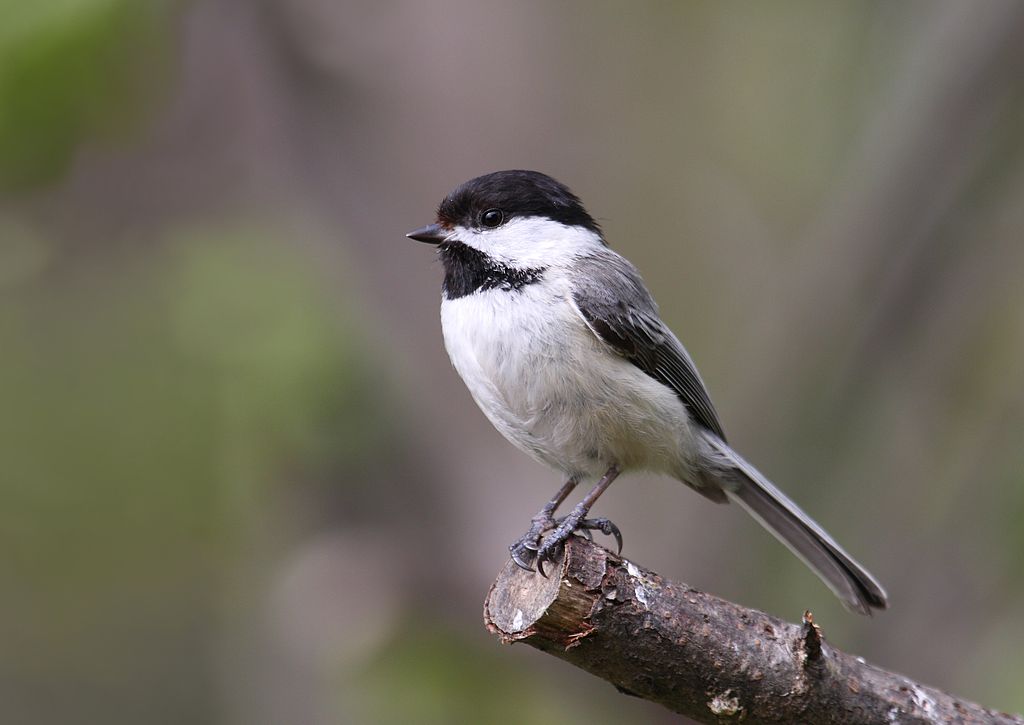
Coloration and Markings: Black-capped Chickadees have gray backs with short, gray wings that have some white edging in the feathers as well as long, gray tails which have some white outer feathers present as well. They have a white underbelly and breast with a flanking of buff coloration at the sides and facially, this bird has a black bib, a wide, white stripe of color through the cheeks to the back of the head, and a large black cap settling at mid-eye level. These birds also have small, triangular black bills.
Size: These birds measure in at 4.7 – 5.9 inches from tip to tail and have wingspans of 6.3 to 8.3 inches wide.
Habitat: Marshes, fields, and essentially any areas where there are trees and shrub cover are potential Chickadee sightings just waiting to happen. They also visit the occasional backyard, so be sure to leave a little something out and you might just get a visit.
Diet: Suet mixed with peanut butter is one of the easiest ways to earn yourself a visit from a hungry Black-capped Chickadee.
American Crow – Corvus brachyrhynchos

Coloration and Markings: American Crows are both clever and instantly recognizable, being completely black even down to their feet! They have long, broad wings and short, squared tails and facially, they have long, straight bills with a noticeable curvature in the upper bill. While they can sometimes appear a little brown when molting into feathers this is the only exception to the ‘always black’ rule of the American Crow.
Size: These birds measure in at 15.8 – 20.9 inches from head to tail and have wingspans of 33.5 to 39.4 inches wide.
Habitat: Crows love fields, forests, and open areas of woods, but these bold birds are also found all over the city.
Diet: Crows will eat just about anything as far as meats, fruits, and veggies, but you do have to be careful what you leave out as they can get a bit picky and expect it every time. Simple fare like unsalted peanuts, rolled oats, and a little suet will do them just fine!
European Starling – Sturnus vulgaris
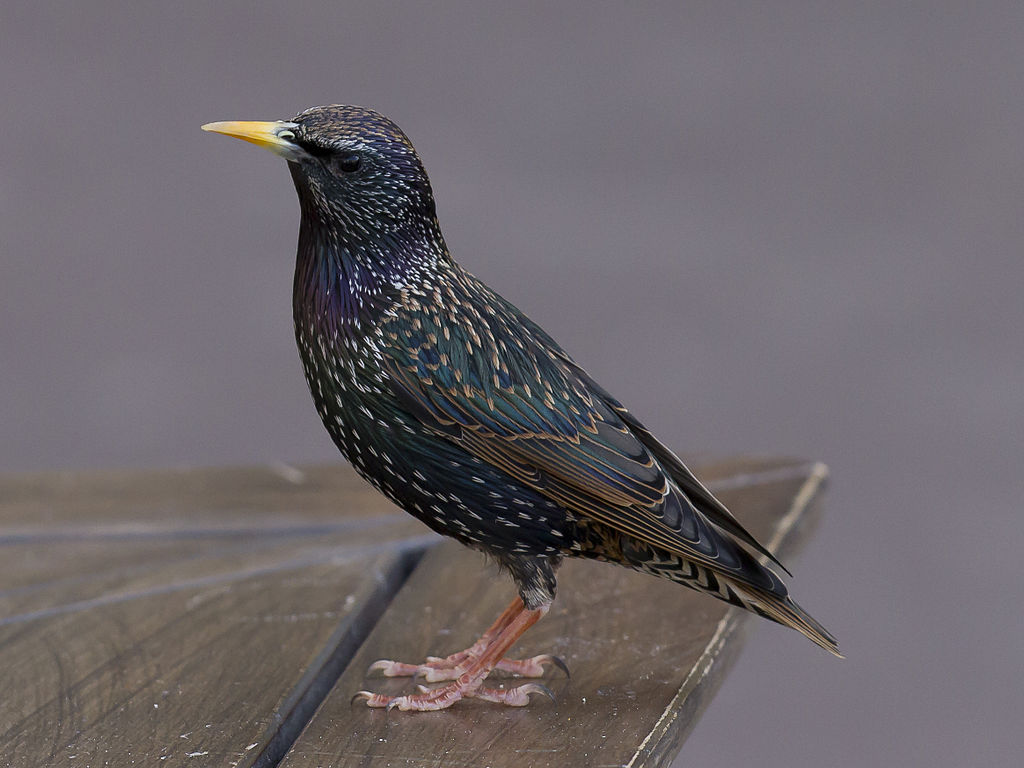
Coloration and Markings: While they look black from a distance, up close you can see that a European Starling actually has a combination of purples and greens making up that lovely summer plumage color. They have long, pointy wings and short tails and facially, these birds have a long, thick yellow bill. In the winter, they make a definite wardrobe-change, molting into new brown plumage with lovely white spots that is definitely worth a closer look.
Size: These birds measure in at 7.9 – 9.1 inches in length and have wingspans of 12.2 to 15 inches wide.
Habitat: While you can find them at farms, these are mostly city-birds and a common site on phone wires, fences, and in backyards with well-stocked feeders.
Diet: Starlings love suet but are preferential to the kind that has corn, peanuts, or other delicious treats mixed inside. That said, they are also happy with wheat and rolled oats and you can keep the suet safe with a Starling-proof feeder if you find that they are eating too much of it and you want to save some for the other birds.
American Robin – Turdus migratorius
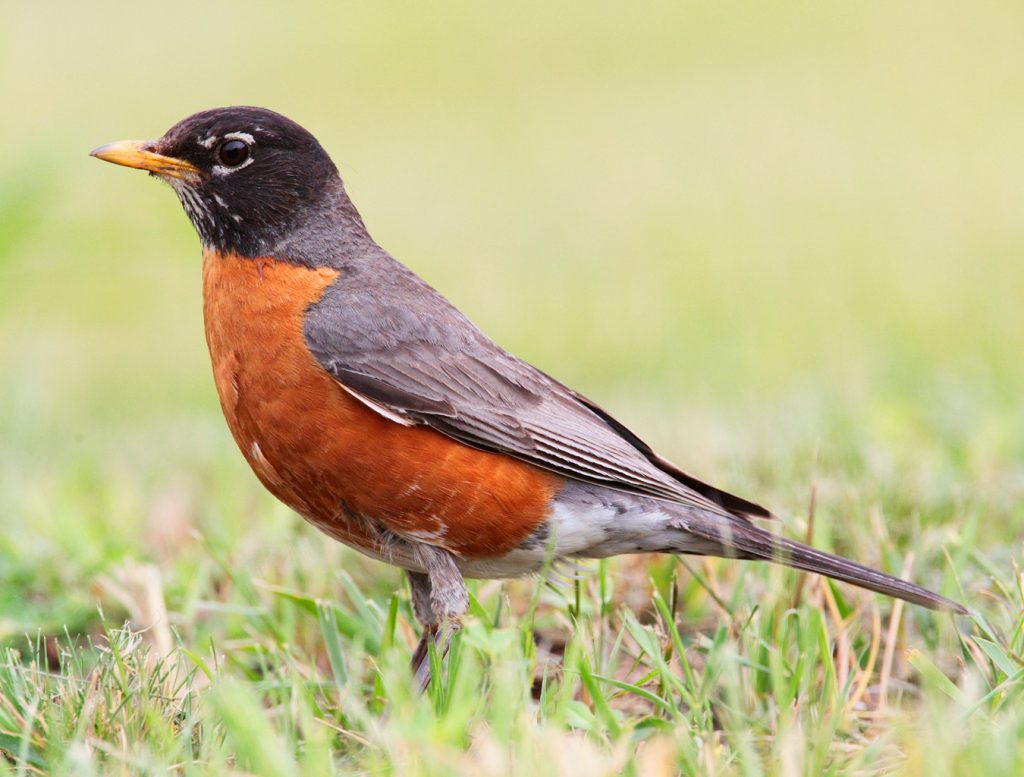
Coloration and Markings: American Robins have grayish-brown backs with medium-length wings of the same color and long, grayish-brown tails. The rump of this bird is white, but the underbelly and breast are a dark tangerine hue. Facially, this bird had a black head with a ‘broken’ white eyering and a medium-length, lightly curved yellow bill. Females will have lighter colored heads which contrast less with the back and wings.
Size: These birds measure in at 7.9 – 11 inches from tip to tail and have wingspans measuring 12.2 to 15.8 inches wide.
Habitat: Robins range out far and wide, with sightings occurring in tundra zones, pastures, fields, pine forests, and even golf courses. Parks and backyards are also quite popular for these birds so be sure to keep an eye out for the iconic American Robin.
Diet: Suet, Sunflower seeds, crushed peanuts, and raisins are all favorites of the American Robin which you can use to lure them in for a feeder visit and a closer look!
Washington’s Birds of Spring, Summer, and Early Fall
When the Indian Plum starts to open up and it’s quickly growing greener in the south then spring is approaching. This means a large influx of visitors to Washington state who will keep coming until it starts to get cold. See if you can spot one of the birds we’ve listed below while it’s warm this year:
- Violet-green Swallow
- Black-headed Grosbeak
- Cedar Waxwing
- White-crowned Sparrow
- Summer Tanager
Violet-green Swallow – Tachycineta thalassina
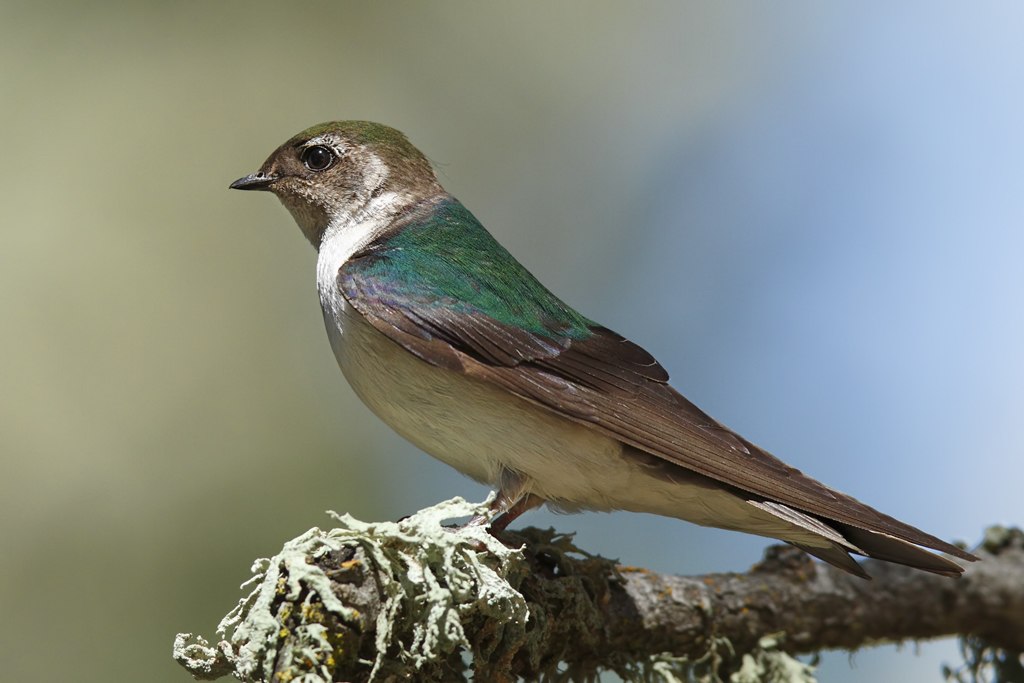
Coloration and Markings: Violet-green Swallows have backs which are green with a mix of bronze and with purple on the lower back. They have long, pointed gray wings which have some green and blue towards the shoulder and a little purple mixed in the wing. They have short purple and gray tails with a slight fork to them and the underbelly and breast of this bird are a lovely snowy white. This white carries up into the face, where this bird is mostly white with the exception of some gray in front of the eyes and a green cap which goes down to the nape of the neck. These birds have small, triangular black bills. Females and juveniles will have grayish-brown caps and backs as well as ducky coloration at the cheek, instead of white.
Size: These birds measure approximately 4.7 inches from tip to tail and have wingspans averaging about 10.6 inches in width.
Habitat: Violet-green Swallows prefer evergreen and deciduous forests, though they may be found in mixed as well. Look for them in open areas such as meadows and copses and especially in areas where a stream is nearby.
Diet: These birds eat mostly flying insects, so it is unlikely that they will visit your feeder. That said, you can try to attract with mealworms but there are no guarantees.
Black-headed Grosbeak – Pheucticus melanocephalus

Coloration and Markings: Male Black-headed Grosbeaks have black backs with small black and white wings as well as long, black and white tails, which are largely white on the underside of the tail approaching the tip. They have white rumps with an orange spot on a partially white underbelly with the remainder of the underbelly and breast becoming completely orange as the coloration moves up. These birds have black faces and large, powerful curved black bills. Female and Juvenile Grosbeaks will have brown instead of black on their wings, back, and faces and typically a large, orange eyebrow line that curves down to the back of the neck and an orange underbelly and breast.
Size: These birds measure in at 7.1 – 7.5 inches in length and have wingspans of approximately 12.6 inches wide.
Habitat: Found in desert oases, mixed woods, and at the forest’s edge in mountainous regions these birds are a treat to spot. Keep an eye out when you are hiking and you might just sight a Black-headed Grosbeak.
Diet: Grosbeaks love Sunflower seeds, both regular and Striped, and are also fond of Safflower seeds if you have them.
Cedar Waxwing – Bombycilla cedrorum
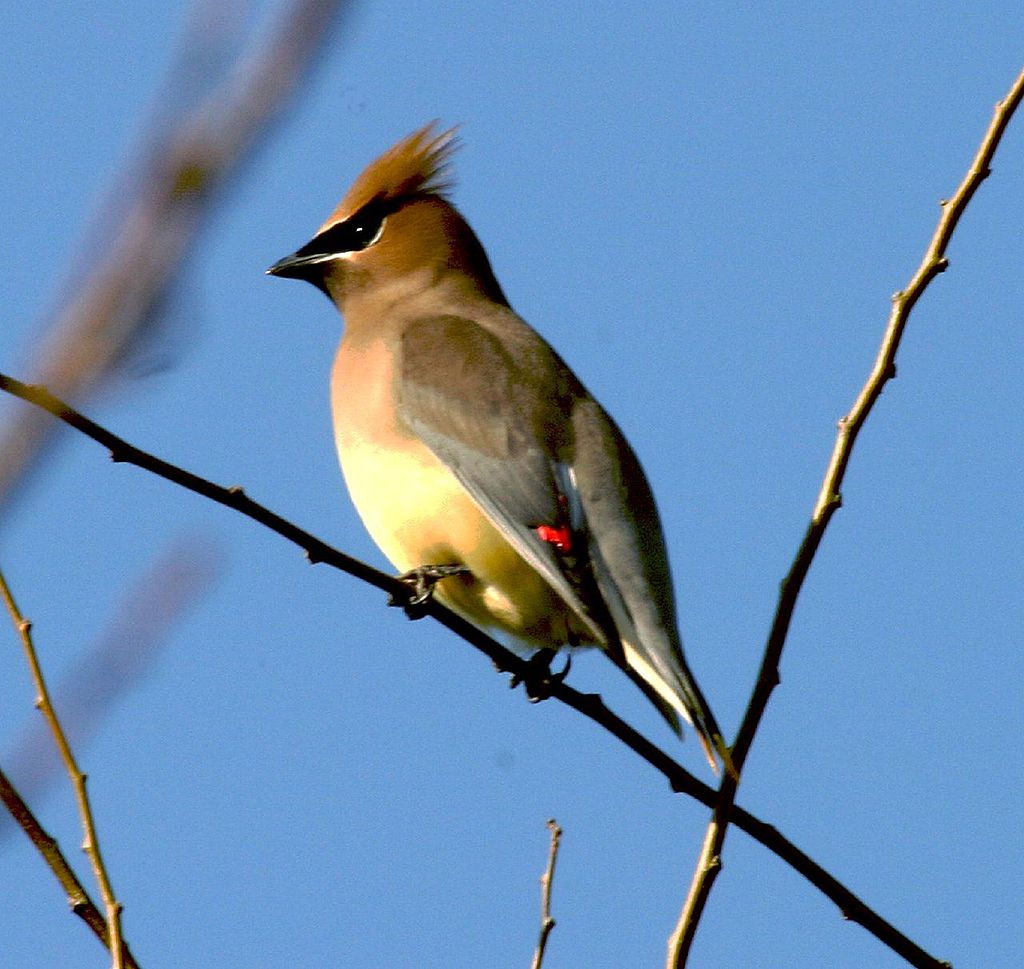
Coloration and Markings: Cedar Waxwings have backs which are light brown at the top and turn into gray. They have small, gray wings which are brown at the shoulders and have a waxy-red arrangement of vertical lines that looks much like a pan-pipe and a white line towards the inner termination of the wing. They have short, squared gray tails which are yellow at the tips and a white rump with their underbelly being yellow. This yellow continues up, turning into brown at the upper portion of the breast, and facially these birds are mostly brown. They have large brown crests and brown ‘beards’ which come down into the breast and they have distinctive upcurving black masks with some white above and below at the front of the eyes. These birds have short, stout, and triangular black bills.
Size: These birds measure in at 5.5 – 6.7 inches in length and have wingspans of 8.7 to 11.8 inches wide.
Habitat: While these birds love the woods you can also seem them at farms, gardens, and especially orchards.
Diet: Waxwings LOVE fruit and will eat just about any of it that you have on hand. While they do prefer it fresh, dried fruits and berries will work in a pinch.
White-crowned Sparrow – Zonotrichia leucophrys

Coloration and Markings: White-crowned Sparrows have brown, streaked backs with small, brown wings which display touches of black and 2 small white wingbars on each wing. They have long, brown tails with a white rump and warm brown at the underbelly, which turns into gray as the coloration moves up and into the breast. Gray colorations continues up past the bird’s long, stout gray neck and stops just under the eyes, where a thin, black eyestripe may be found. Above this is white coloration, followed with another black stripe and finally white at the crown. These birds have short, stout, triangular orange bills.
Size: These birds measure 5.9 – 6.3 inches from head to tail and have wingspans of 8.3 to 9.4 inches wide.
Habitat: These birds love open areas for foraging but they are also quite partial to brushes, brambles, thickets, and thorns. If you have both in an area then this is a good location for a potential White-crowned Sparrow sighting.
Diet: Nyjer thistle and hulled Black Oil Sunflower seeds are the best way to go with this bird. Leave them out and you might just get a visit from the White-crowned Sparrow!
Summer Tanager – Piranga rubra
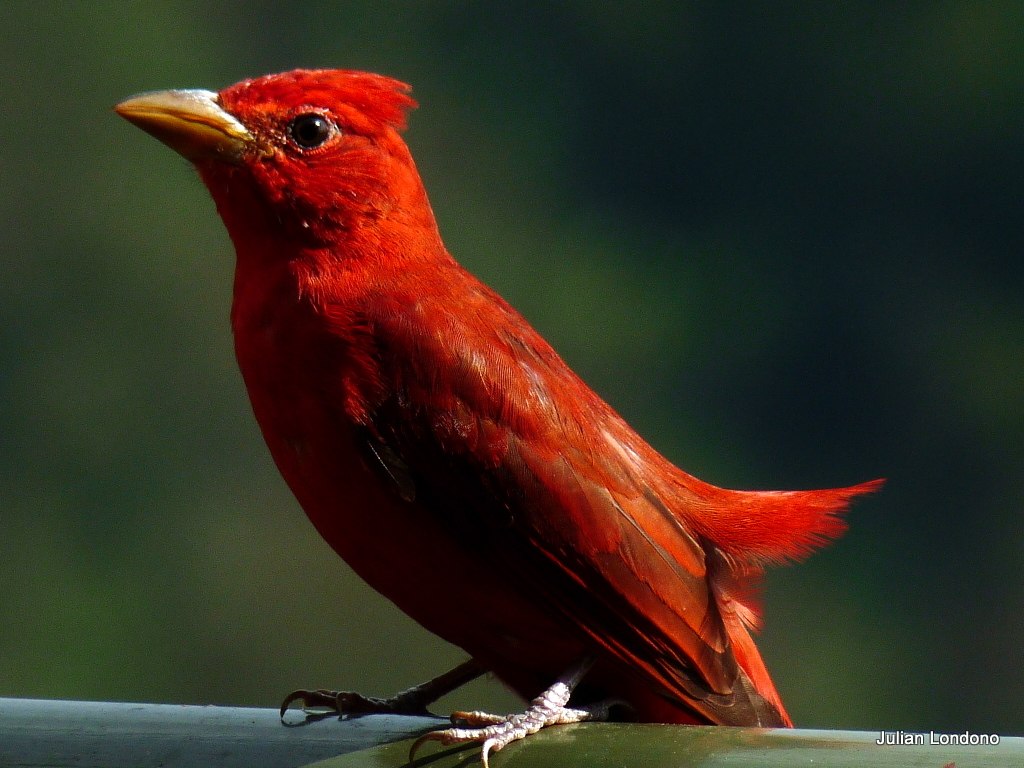
Coloration and Markings: Male Summer Tanagers are quite striking, being completely red with the exception of their bills. They have short, red wings and long, red tails, with the red coloration being lighter at the undersides and they have large, powerful, and slightly curved reddish-yellow bills. Females and Juveniles will have yellowish heads and greenish coloration on the rest of their bodies, with lighter colored bills. Juvenile males will also sometimes display a heavy combination of yellow and red when they are molting and approaching adulthood.
Size: These birds measure in at approximately 6.7 inches from head to tail and have wingspans averaging 12 inches in width.
Habitat: These birds favor the edge of deciduous woods as well as Pine/Oak mixed woodlands. They do occasionally venture out into parks and backyards, however, so be sure to leave a little something out for them. This is one sighting that you definitely don’t want to miss.
Diet: Primarily insectivores, you can potentially lure this bird with dried or live mealworms, but they also supplement their diet with berries so some whole blackberries or chopped cherries might also do the trick!
Washington’s Fall and Winter Birds
With nighttime temperatures falling as low as -10 degrees Fahrenheit, it’s safe to say that Washington has very robust winters. Despite this, a number of brave and dedicated flying foragers are out there and could use your assistance while it’s so cold outside. Be sure to leave a little something out in the feeders for one or more of these winter birds of Washington this year:
- Anna’s Hummingbird
- Gray Jay
- Tricolored Blackbird
- Brown Creeper
- Rusty Blackbird
Anna’s Hummingbird – Calypte anna

Coloration and Markings: Anna’s Hummingbirds have gray and green backs, with some yellow above and below their short, curved gray wings. They have broad, gray tails, which display some green and yellow and you will also see white at this bird’s rump. The underbelly and breast of this bird are greenish-gray with a flanking of yellow and some white and gray towards the top of the breast. Facially, these birds have reddish-gray faces with a bright, neon pink under the cheeks and towards the back and top of the head, along with splashes of yellow and green. A yellow eyebrow line is often present and this bird has a long, thin, and straight black bill.
Size: These little Hummingbirds measure in at an average length of 3.9 inches from head to tail and have wingspans of approximately 4.7 inches wide.
Habitat: Anna’s Hummingbirds have a wide range of environments where they may be found, such as desert scrubs, the forest’s edge (especially with water nearby), parks, and even residential streets. If you have flowers in your backyard then this is a bonus but even if you don’t you might still get a visit. Be sure to leave a little something out to show that you care!
Diet: These birds will sip sugar water from your Hummingbird feeder but you might also have a little luck with some live or dried mealworms as well.
Gray Jay – Perisoreus canadensis
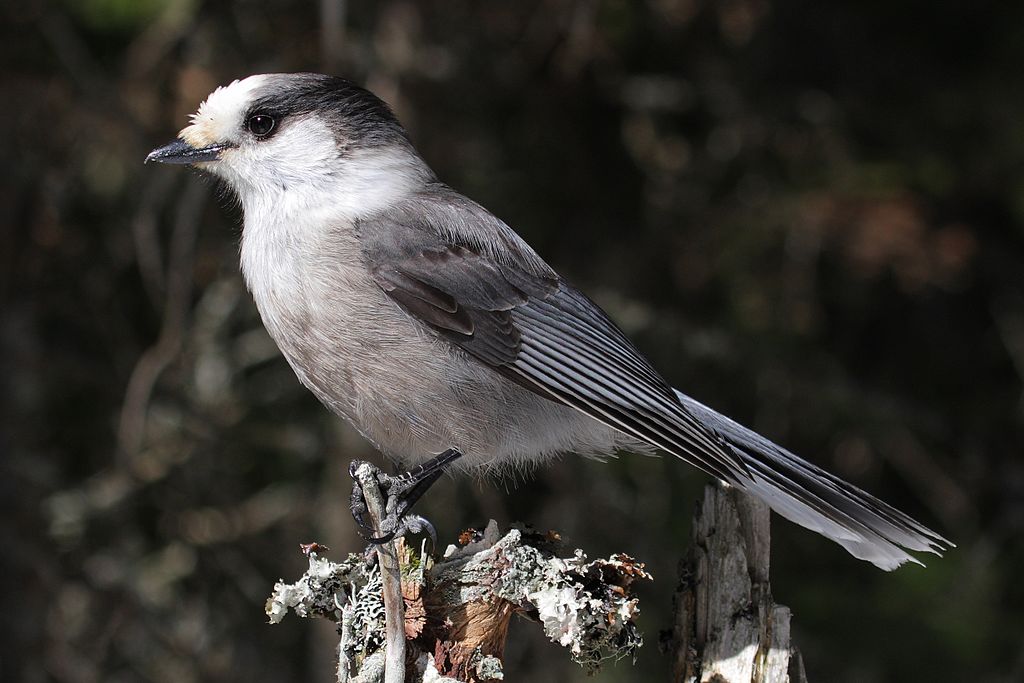
Coloration and Markings: Gray Jays have dark gray backs with small, dark gray wings and long, gray tails, with are white on the tips of the undersides and lighter in color there as well. The underbelly and breast of this bird are a lighter gray as well though a ‘v’ of white coloration will be seen at the top of the breast, coming down from the face. Facially, these birds are snowy white, with the exception of gray color coming from the back of the eyes and fanning out onto the back of the head. These birds have short, stout, and triangular black bills.
Size: These birds measure in at 9.8 – 11.4 inches in length and have wingspans which average 18 inches in width.
Habitat: These birds inhabit boreal forests and are especially fond of areas which are dense with evergreens. Evergreen deciduous mixes are also fine for this bird and it may also be found in wooded mountains.
Diet: Suet, cracked corn, and grapes are all 3 favorites of the omnivorous Gray Jay. Give this combination or something similar a try and you might just get yourself a feeder visit.
Tricolored Blackbird – Agelaius tricolor

Coloration and Markings: Male Tricolored Blackbirds are beautiful and easy to identify, being completely black with the important exception of a white and red mark at the shoulder that looks rather like a white sharks-fin tipped in red when the large wings are at rest. This bird has a medium-length, notched black tail and female Tricolors will look quite a bit different. They are brown, with heavily streaked bellies and a cream-colored eyebrow line present. These birds have thick, pointy, and medium length black bills. Juvenile males are easily recognized, being a mix of browns and blacks with the brown lessening gradually as they approach adulthood.
Size: These birds measure in at 7.1 – 9.4 inches from head to tail and have wingspans of 10.2 to 13 inches wide.
Habitat: Tricolored Blackbirds are most at home in the wetlands but you can also spot them in farms, fields, feedlots, and the occasional backyard with a well-stocked feeder.
Diet: While these birds eat a lot of insects they are also fond of grains and can be tempted to your feeder with a little preparation. Leave out some wheat and rolled outs for best results and if you have them, some live mealworms might well get their attention too.
Brown Creeper – Certhia americana
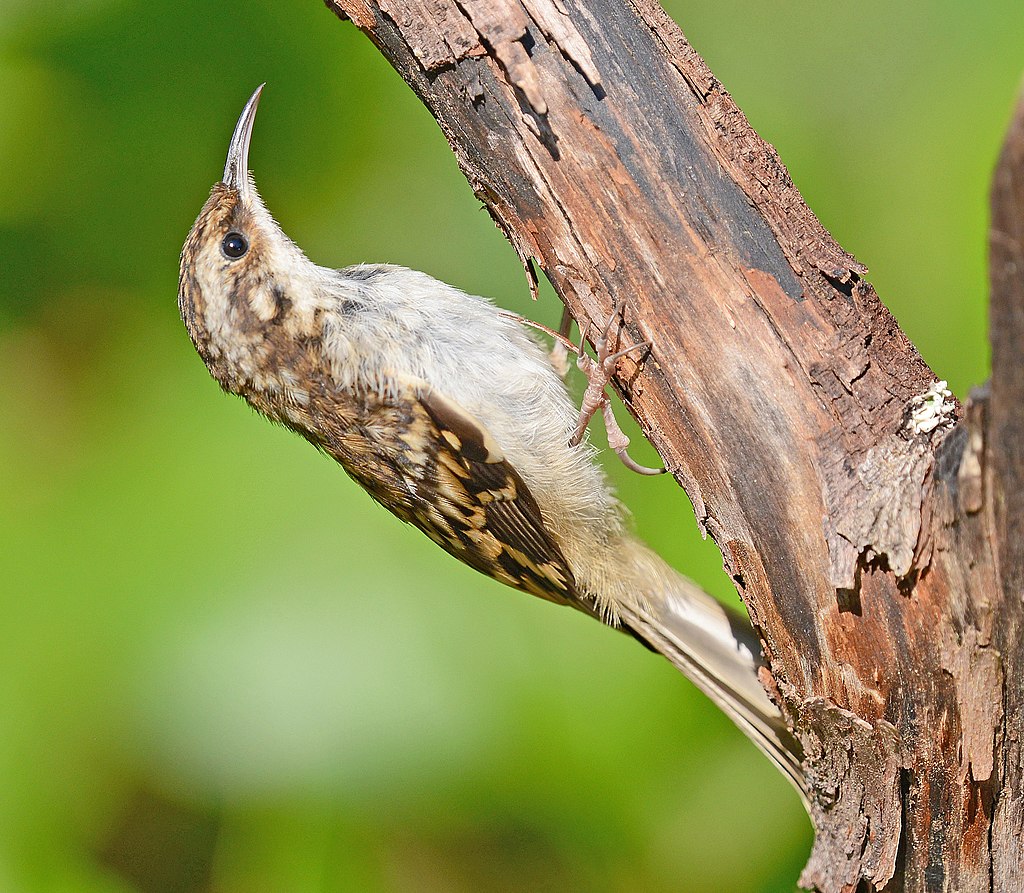
Coloration and Markings: Brown Creepers are masters at blending in with tree bark, with their backs being a heavily white-streaked brown that extends into their medium length wings where you will also see some black and white striping towards the tips. These bird have long, thin streaked tails and the underbelly and breast of this bird will be snowy white, with a creamy-tan flanking at the underbelly. Facially, these birds are white all the way up to their cheeks and under the bill, with the upper portions of their heads being brown and white streaked for better blending and you will also see a buffy stripe over the eyes. Brown Creepers have long, curved black or black and yellow bills.
Size: Small birds, Creepers measure in at 4.7 – 5.5 inches in length and have wingspans of 6.7 to 7.9 inches in width.
Habitat: These birds favored evergreen or evergreen and deciduous mixed forests and may be found in both high and lower elevations. During the winter they tend to range and may sometimes be found in deciduous woods or even parks or backyards.
Diet: Suet, peanut butter, and cracked corn are 3 favorites of the Brown Creeper which you may use to lure them in to your feeder for a closer look.
Rusty Blackbird – Euphagus carolinus

Coloration and Markings: In the warmer months, the Rusty Blackbird simply looks like a regular blackbird, with medium-length wings and long, thin tails. You will notice, however, yellowish eyes and once winter comes around then the bird’s coloration makes a lovely change. At this time it assumes a mix of rust coloration that you will see on the upper back, the underbelly and breast, as well as the face which will now have a distinctive diamond-shaped black mask. These birds have long, straight, and pointy black bills. Females will be a mix of browns and grays but will also display some rust coloration in winter and during breeding season males will be a much shinier black.
Size: These birds measure in at 8.3 – 9.8 inches in length and have wingspans of approximately 14.6 inches in width.
Habitat: These birds love wetlands and may even sometimes be found in fields which are flood-prone. Generally any area which becomes fairly saturated with water during a good rain is a potential spot for sighting the Rusty Blackbird.
Diet: Nyjer thistle and Black Oil Sunflower seeds will get you a better response than suet when it comes to the Rusty Blackbird. These birds are considered vulnerable so if you spot one then you have just been given quite the rare treat.
Supporting cast (Other Backyard Birds of Washington that might pay you a visit)
We like to include in our articles another batch of year-round birds that you can see anytime you are out and about. Our ‘supporting cast’ birds might not get that fancy front-page space but they are certainly well worth your while. See if you can spot one of our beautiful supporting cast birds this year:
- Northern Flicker
- House Finch
- Song Sparrow
- Pygmy Nuthatch
- Dark-eyed Junco
Northern Flicker – Colaptes auratus
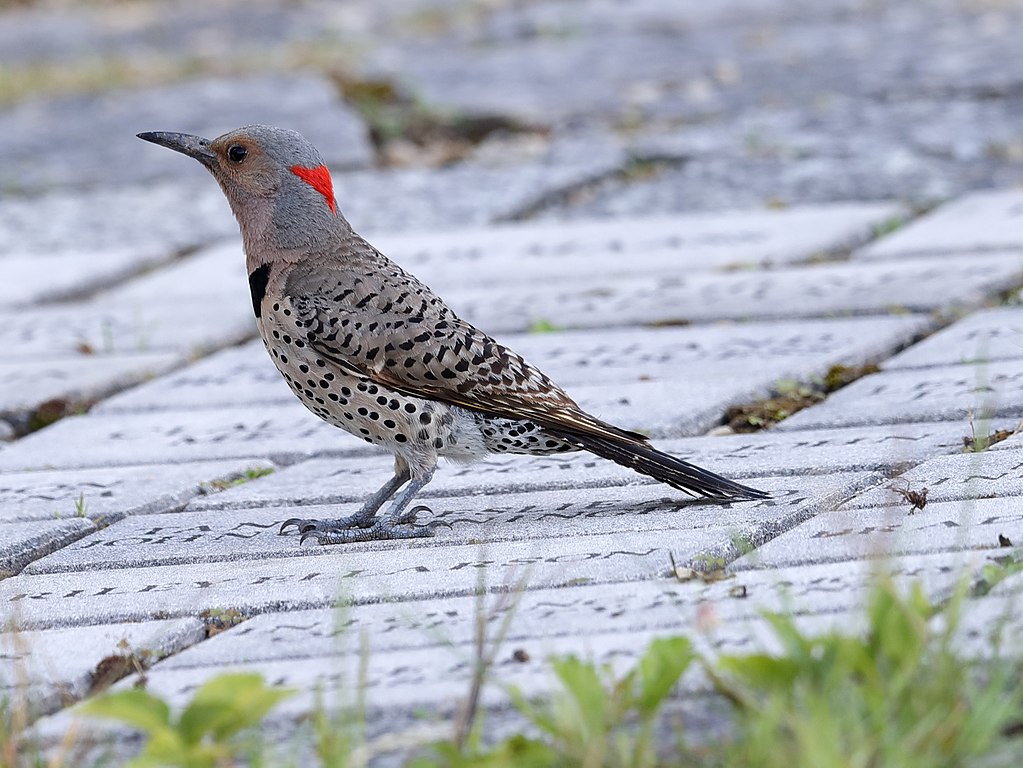
Coloration and Markings: Northern Flickers have brownish-gray backs with medium-length wings which are brownish-gray and have an assortment of mottled black marks throughout their length. They have long, pointed tails which are brown and gray on top and black-tipped but either red or yellow underneath. The underbelly and breast of this bird will be a mix of gray and tan with distinctive black spots and an inverted crescent at the top of the breast. Facially, this b ird is gray with a red cheek-stripe and brownish coloration in front of and above the eyes. These birds have long, thin, and slightly curved black bills.
Size: These birds measure in at 11 – 12.2 inches from head to tail and have wingspans of 16.5 to 20.1 inches wide.
Habitat: These birds love open areas of woods, be they copses, meadows, or simply the forest’s edge. You can sometimes find them in mountainous regions as well, provided there are trees and enough open area for the bird to feel safe.
Diet: While they like suet, Flickers will also eat Sunflower seeds of any kind, peanuts, and just about any sweet fruits that you have on hand.
House Finch – Haemorhous mexicanus
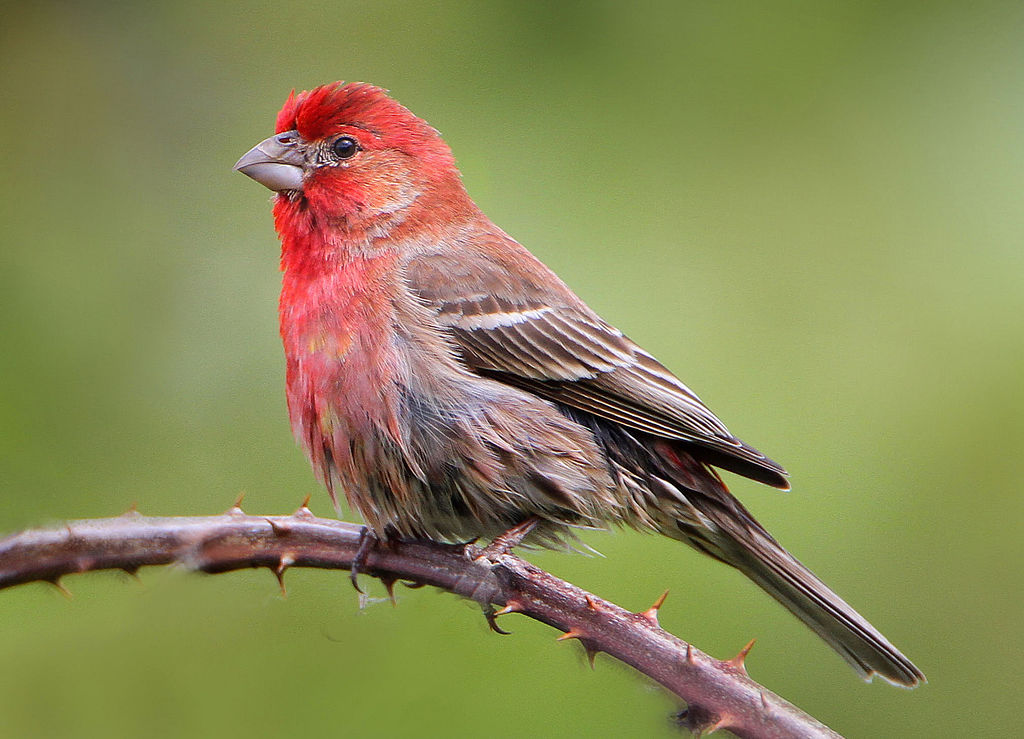
Coloration and Markings: Male House Finches have gray backs with small, gray wings, which bear vertical black lines throughout their length as well as 2 white wingbars. They have long, gray tails which have white on the edges and while their underbellies will be white with black or dark brown streaks this coloration quickly becomes a rosy red as it moves up the breast. This red coloration carries up into the face, where it is seen on the throat and just in front of the cheeks, as well as above the eyes on the otherwise gray head. These birds have a grayish-brown eyestripe that passes the eyes and curves around to frame the cheek and they also have short, stout bills with some curve visible in the upper and lower bill. Females will lack the red color and have blurry streaks at the underbelly and breast as well as a lack of facial markings.
Size: These birds measure in at 5.1 – 5.5 inches in length and have wingspans of 7.9 to 9.8 inches wide.
Habitat: While they may be found at the forest’s edge, House Finches are commonly seen in the city, farms, or parks. They do range out far and wide however, and may also be found in grassy fields or even deserts with a bit of scrub cover present.
Diet: Black Oil Sunflower seeds, Nyjer Thistle, and White Proso millet are all good choices for attracting the attentions of the lovely House Finch.
Song Sparrow – Melospiza melodia
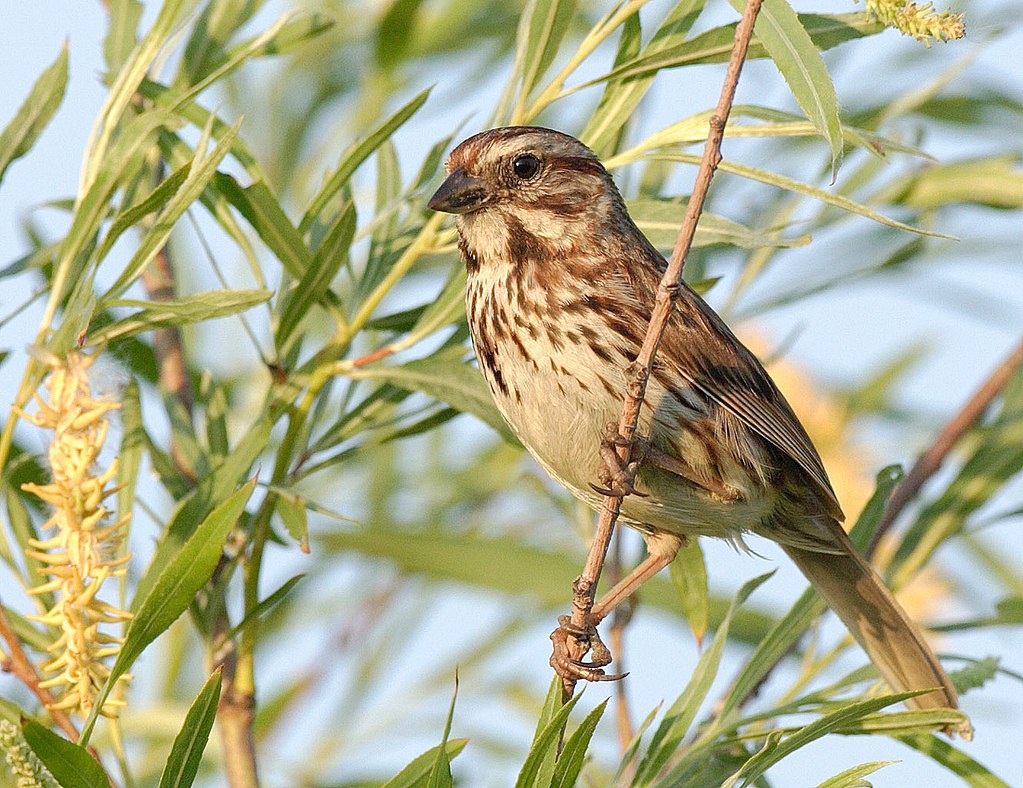
Coloration and Markings: Song Sparrows have gray backs with heavy warm, brown streaking present. They have short brown and gray wings, with heavier gray towards the outer edges and wingtips, and they have medium-length, perky brown tails. The underbelly and breast of this bird are an off-white to gray with a streaking of lighter reddish-brown and facially, These birds have gray faces with a white mustache line and brownish-red stripes above and below it as well as a thin, brown eyeline and brown at the crown. These birds have small, thick, and conical gray bills.
Size: These birds measure in at 4.7 – 6.7 inches in length and have wingspans of 7.1 to 9.4 inches wide.
Habitat: Song Sparrows may be found in a number of environments, such as desert washes, the forest’s edge, or even beside streams or marshes. They are frequent visitors to backyards so be sure to leave something out to get their attentions.
Diet: Primarily insectivorous, these birds do supplement their diet with seeds, so some Nyjer thistle and hulled Black Oil Sunflower seeds might just get their attentions.
Pygmy Nuthatch – Sitta pygmaea

Coloration and Markings: The Pygmy Nuthatch has a bluish-gray back with medium-length wings and a short, squared tail of the same color. White spots may occasionally be seen on the wings and the underbelly and breast of this bird are a creamy buff color that carries up into the face, terminating at a white line just under the eyes. The top of the head and the back of the neck will be brown and these birds have long, pointy bills which are often gray with black tips. A close look may show darker coloration crossing the eyes but this can be hard to see unassisted from a distance.
Size: These tiny birds measure in at a mere 3.5 – 4.3 inches in length and have wingspans of approximately 7.75 inches wide.
Habitat: The Pygmy Nuthatch loves pine forests and may be found in them at lower, middle, and sometimes even higher elevations. They do range out and visit the occasional backyard, however, so be sure to leave out something tasty for them.
Diet: Suet, crushed peanuts, and Black Oil Sunflower seeds are a surefire feeder combination for catching the attentions of the hungry Pygmy Nuthatch.
Dark-eyed Junco – Junco hyemalis

Coloration and Markings: Dark-eyed Juncos typically display dark gray or brown backs, with medium-length gray wings and long, gray tails which are white on the undersides. The underbelly and breast of this bird are white as well, with a heavy flanking of gray which decreases as the color moves up the breast. The overall effect is rather like the bird has been dipped in some white plaint or lightly bleached, neatly and evenly across the bottom 1/3 of it’s body. Facially, this bird is mostly gray with the exception of a small amount of black in front of and around the eyes and just below the stout, medium-length pink bill.
Size: These birds measure 5.5 – 6.3 inches from tip to tail and have wingspans of 7.1 to 9.8 inches wide.
Habitat: Juncos like to spend their time in coniferous or mixed coniferous woods but you can also find them in fields, parks, and backyards with well-stocked feeders.
Diet: Juncos will sometimes eat suet but generally it has fallen out of the feeder onto the ground. They seem to prefer seeds, with Nyjer thistle and hulled Black Oil Sunflower being tempting treats for the Dark-eyed Junco.
Washington Bird Buffet
When you are setting up your feeder you’ve got some tough decisions to make. There are some seeds that can attract a number of birds but not always the ones that you want. Also, there are the occasional rare birds that you want to get the attentions of and you also want to make sure that you’ve got something which they will like out. How do you decide? We’ve got some suggestiong from Washington’s ‘Northwest Seed and Pet’ as well as a few of our own to help you in making your own special combination so that you can attract the birds that you like. Give some of these suggestions a try and see what happens:
- Suet (especially mixed with peanut butter)
- Black Oil Sunflower
- Assorted fruits (bananas raisins, oranges, and whatever else you have on hand)
- Grape jelly
- Safflower
- Nyjer Thistle
Washington Birding Hot Spots
When you’ve got a little free time a great way to spend it is to get out there so you can see your favorite feathered friend in their native element. The Chirparazzi are pros at finding these winged celebrities and have a few recommendations to send your way. If you don’t find a spot close to you, don’t panic, just check our reference link below and something is likely to be just around the corner. Check out one of these birding hot spots when you get the chance… is well worth your while!
- Northern hotspot – Whitehorse Trail
- Eastern hotspot – Fish Lake Trail
- Southern hotspot – Klickitat Trail
- Western hotspot – Discovery Trail
- Central hotspot – Coal Mines Trail
Detailed descriptions of each location as well as information regarding visiting and what birds you can see at these locations may be found at https://www.traillink.com/stateactivity/wa-birding-trails/
In Closing
Today we’ve taken some time to explore the birding world of Washington. As you can see, it’s not just intense politics that define this state. You’ve got enough bird species present to keep you happily busy for a long, long time. Just be sure to set up those feeders and since the winters are cold, a heated birdbath certainly can’t hurt either. Beyond this, just be patient. Whether you are going out to see them or luring them into your backyard one thing is certain in Washington. There’s no shortage of beautiful birds to see! Until next time, we wish you our birding best!
